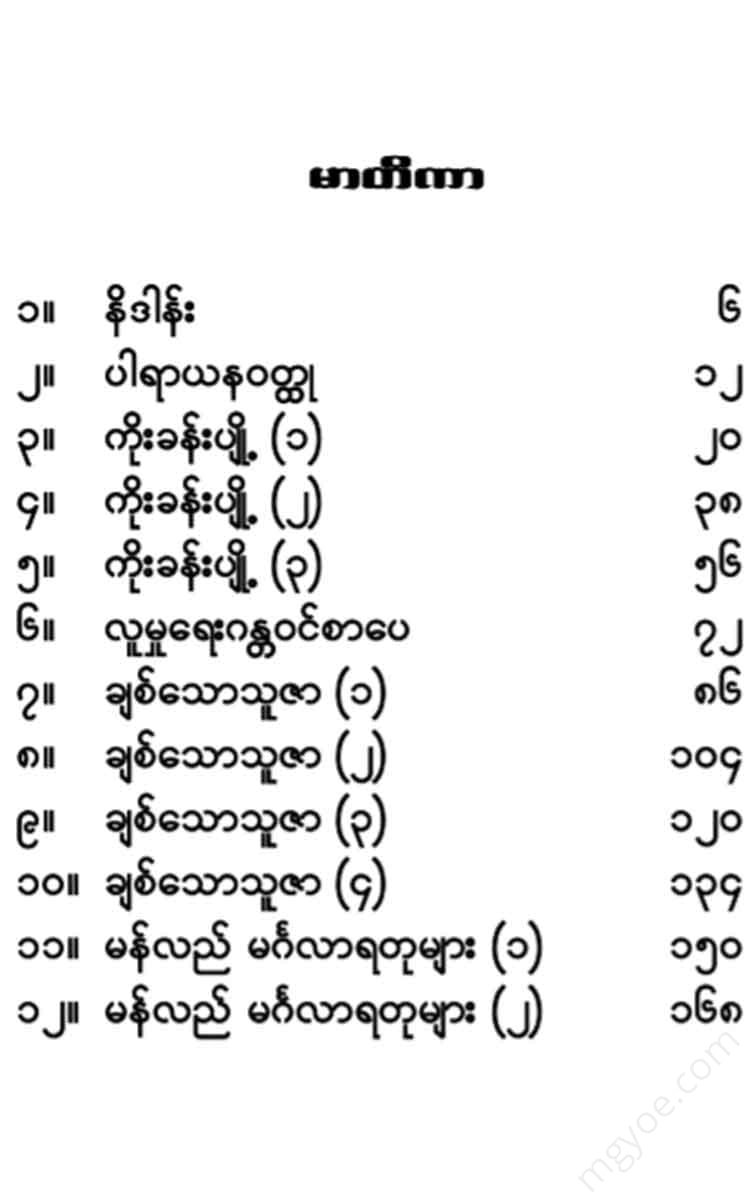Other Websites
Aung Thin - Introducing the Classic for the New Generation
Aung Thin - Introducing the Classic for the New Generation
Couldn't load pickup availability
Introduction
The title, “Introducing a Classic for a New Generation,” suggests the intent. But I’ll go into a little more detail.
the purpose
(1) Which classic books should young people know about?
I want young people to know, in general, what makes good literature good, and why it became classic literature.
(2) I hope that young people with a “literary blood” will be awakened to the desire to search for relevant books themselves and read them thoroughly.
The main thing I want to emphasize is that I'm not trying to compile a comprehensive book. It's really just an introduction to young people.
Presentation
As they say, in a small classroom/small conversation, the intention is to write lightly, not in a big way -
(1) I will write as I speak.
(2) When presenting the good aspects of the relevant literature, we will include excerpts from your readings.
(3) Interesting, not following the procedures of major research books, but rather engaging and relevant.
If I remember any important things, I'll add them without hesitation.
(4) I think that if it is information that will increase the awareness and sharpen the reasoning skills of young people, I will add it quickly.
Two professors and teachers
Almost every young person has heard that the Parayana Vutthu was written by Sayadaw Shin Maha Thila Vamsa. When we say Shin Maha Thila Vamsa, we always think of Shin Maha Rattha Shara. When we say Rama, the meaning is the same. In our time, when we say “Zawgyi”, we also think of “Min Suwan”. These two great Sayadaws have become inseparable. In the past, we used to respect and remember Shin Maha Thila Vamsa, who composed “Prayer Prayer” and “Paramitaw Khan Poh”, and Shin Maha Rattha Shara, who composed “Koh Khan Poh” and “Samwara Poh”, as great literary experts, in other words, as the early poets of Burmese literature. Now that we are young, we have learned about their writings, When I carefully examine their lives, I feel a newfound respect for these two professors and teachers who truly strived to "improve the next generation."
Think about it - aren't they the two principal abbots (rectors) of two contemporary monasteries (universities)?
I have to say that the monastery is a collection of schools. “Thai” means a group, “Hong” means a large group of schools. For example, let’s say Thayet Taw Monastery - there are many separate schools in that monastery. They live separately with their schools and their respective abbots. The abbot who manages the entire monastery is the head abbot, the main abbot. It’s like our university. Isn’t a university a collection of colleges? A collection of colleges is called a university. That’s why in the old days before the war, Yangon College, Jackson College, Teacher Training College, and Medical College were all together, so they used to translate it into Burmese as “Rangoon University Monastery”. If you look at old university magazines, you will see that they are written as “Rangoon University Monastery Magazine”.
The two great monks, the great sages, the great monks, the great rector of their time. The great teachers. Aren't the real teachers of the school people who think day and night about what to do to improve the new generation? "A good teacher, a good disciple," they want a disciple who leaves their school to be strong and strong even if he doesn't become a famous person in the world. We see this kind of generosity reflected in their writings.
I don't think the monk wrote a book like "Parayanavutthu" on a whim. I think the idea to write a book came from his disciple's sermon. Okay, let's discuss "Parayanavutthu".
What is a real teacher?
Let the new generation prosper.
What to do day and night
Those who are plotting, right?
"A good teacher makes a good student"
I left my school.
A disciple is in the middle of the human world.
Even if it doesn't turn out to be a piece of cloth, it's still a piece of cloth.
They want it to happen.
Parayanavattha
Sayadaw Mahasilawansa (815-880) (1453-1518) completed the compilation of the Parayanavatthu in 863 (1501). The book is now about 500 years old.
“Parayana” is para = other side + ayana = path. It means the path to the other side of samsara, the path to Nibbana. The name Parayana is taken from the Buddha’s Kuddaka Nikaya Parayana Sutta. The story of the Parayana Sutta is that a great ascetic named “Bavari” sent his sixteen disciples to the Buddha to ask him questions. The questions were asked with the mind and the Buddha answered them verbally.
The main goal of the Sayadaw (teacher of the school) is to make the new generation of young people, whether they are monks, laypeople, or virtuous people, become good and virtuous people. If you look at the introduction, you can clearly see the Sayadaw's goal. Look, in the time of God, the people who are faithful and devoted to God, love their sons and daughters in this way.
Dear children... As monks, let us learn from the two great masters, Sariputta and Moggallana. Let us compare the two great masters.
He said, "If you are one person, you should learn the ways of these two noble men, the wise and the wise."
Discipline of a son and a daughter is -
Dear daughters... even though you are monks... learn from the conduct of the two arahants, Khema and Uppalavana.



